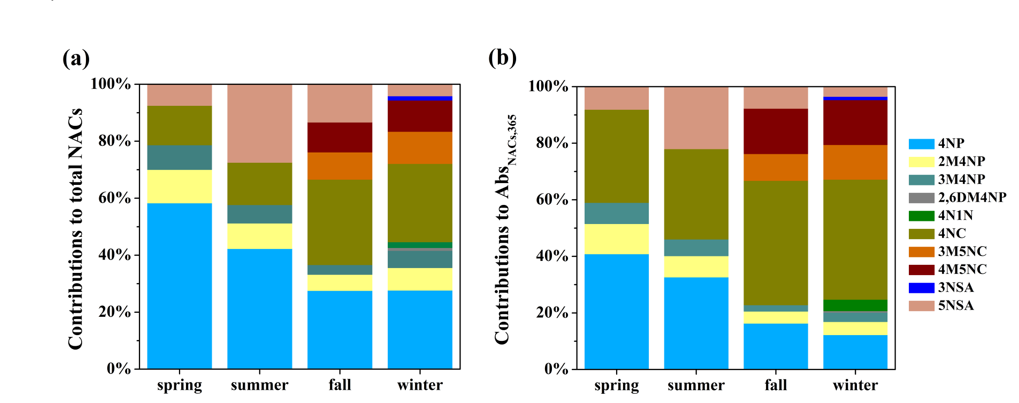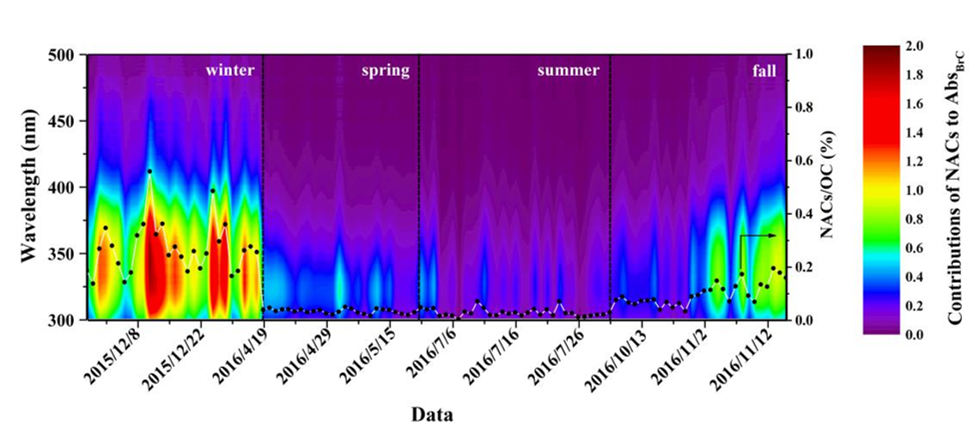Yuan, W., Huang, R. J.*, Yang, L., Ni, H., Wang, T., Cao, W., Duan, J., Guo, J., Huang, H., and Hoffmann, T.: Concentrations, optical properties and sources of humic-like substances (HULIS) in fine particulate matter in Xi'an, Northwest China, Sci. Total Environ., 789, 147902, 2021.
Nitrated aromatic compounds (NACs) are a group of key chromophores for brown carbon (light-absorbing organic carbon, i.e., BrC) aerosol, which affects atmospheric radiative forcing, human health and ecosystems. The chemical composition and sources of NACs and their contributions to BrC absorption, however, are still not well understood.
A research group led by Prof. HUANG Rujin from the Institute of Earth Environment (IEE) of the Chinese Academy of Sciences studied the seasonal variations of concentration and sources of NACs, and evaluated the optical properties of NACs and
their contributions to BrC light absorption.
Both the total concentrations and contributions from individual species of NACs show distinct seasonal variations. The seasonally averaged concentrations of NACs are 2.1 (spring), 1.1 (summer), 12.9 (fall), and 56 ng m-3 (winter). Thereinto, 4-nitrophenol is the major NAC component in spring (58 %). The concentrations of 5-nitrosalicylic acid and 4-nitrophenol dominate in summer (70 %), and the concentrations of 4-nitrocatechol and 4-nitrophenol dominate in fall (58 %) and winter (55 %). The NAC species show different seasonal patterns in concentrations, indicating differences in emissions and formation pathways.
Source apportionment results using positive matrix factorization (PMF) further show large seasonal differences in the sources of NACs. Specifically, in summer, NACs were highly influenced by secondary formation and vehicle emissions (~ 80 %), while in winter, biomass burning and coal combustion contributed the most (~ 75 %). Furthermore, the light absorption contributions of NACs to BrC are wavelength-dependent and vary greatly by season, with maximum contributions at ~ 330 nm in winter and fall and ~ 320 nm in summer and spring. The differences in the contribution to light absorption are associated with the higher mass fractions of 4-nitrocatechol (λmax = 345 nm) and 4-nitrophenol (λmax = 310 nm) in fall and winter, 4-nitrophenol in spring, and 5-nitrosalicylic acid (λmax = 315 nm) and 4-nitrophenol in summer. The mean contributions of NACs to BrC light absorption at a wavelength of 365 nm in different seasons are 0.14% (spring), 0.09% (summer), 0.36% (fall), and 0.91% (winter), which are about 6–9 times higher than their mass fractional contributions of carbon in total organic carbon.
This study, published in Atmospheric Chemistry and Physics, highlighted the important impact of chemical composition and sources of BrC on their optical properties.

Fig.1 Average contributions of individual nitrated aromatic compounds to (a) the total concentration and (b) the total light absorption at a wavelength of 365 nm of particulate nitrated aromatic compounds in four seasons.

Fig.2 Time series of the light absorption contributions of total NACs to the absorption coefficient of brown carbon over wavelengths from 300 to 500 nm (color scale and left axis) and the ratio of concentration of NACs to organic carbon (dots and right axis).

